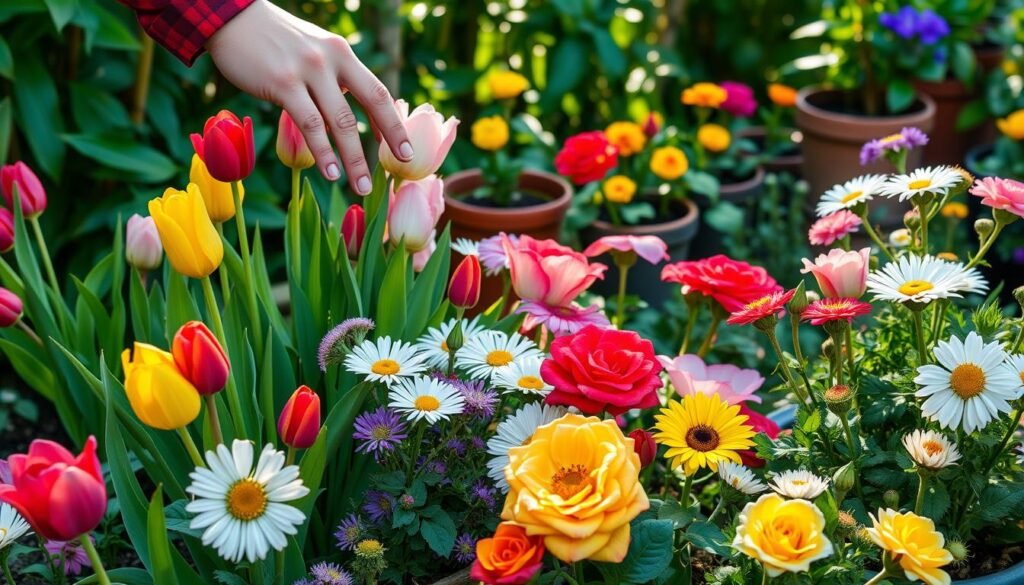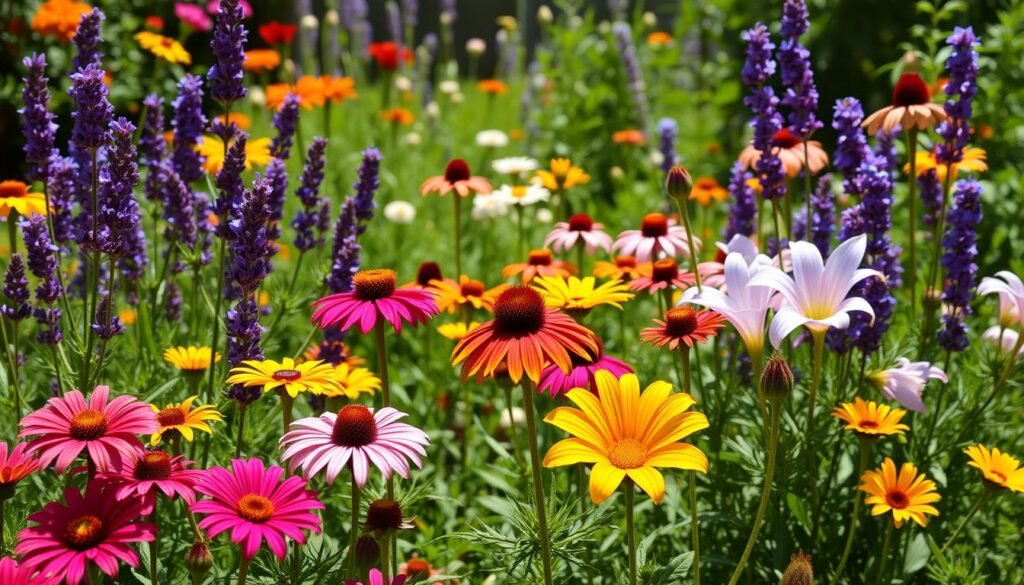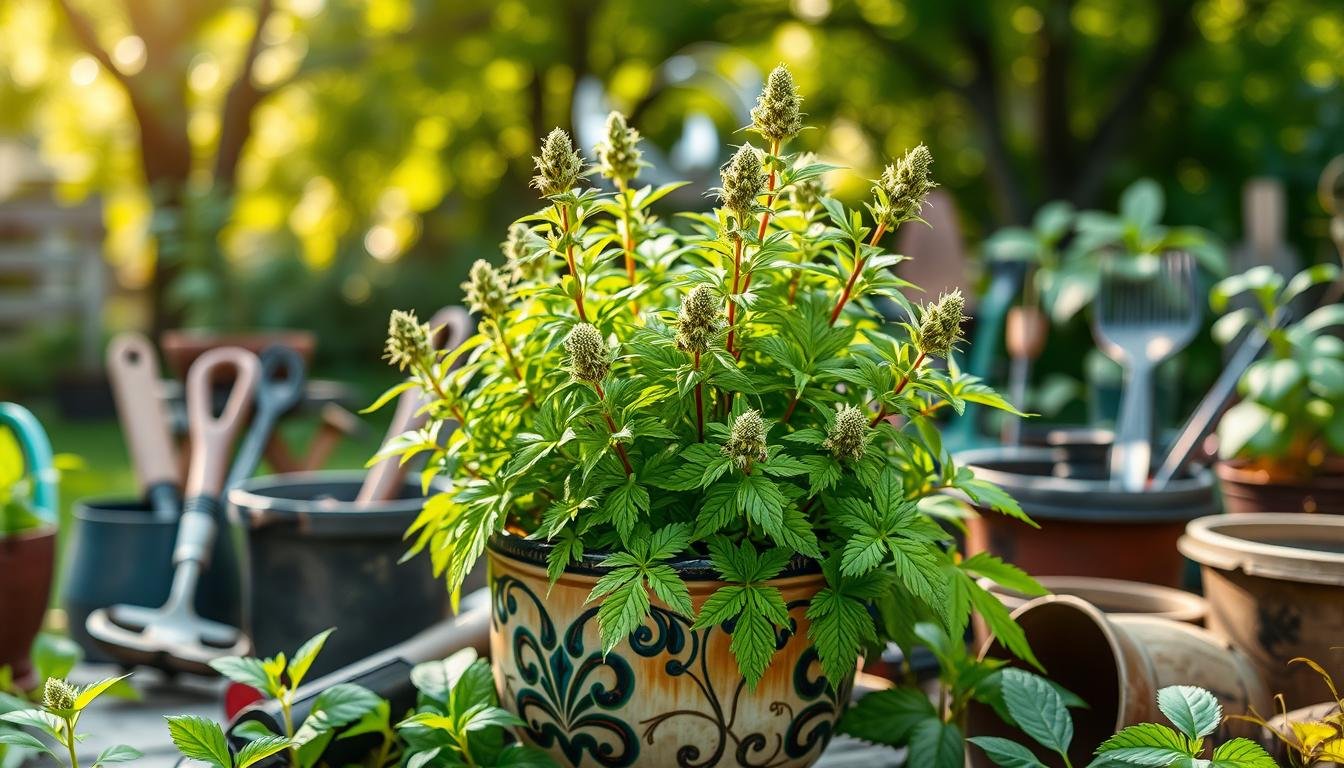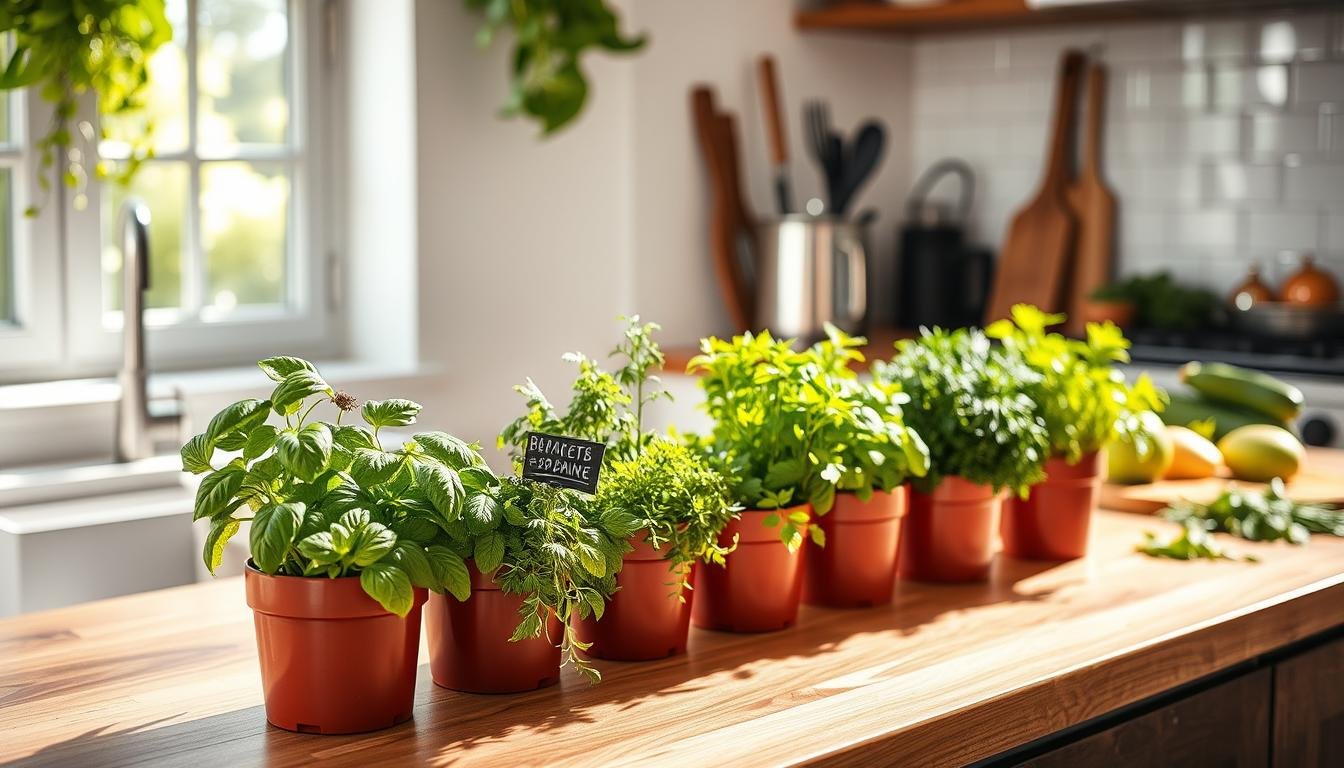Did you know more than 80% of U.S. households garden? Flower gardening does more than just make spaces look pretty. It also makes us feel good inside. It doesn’t matter if you’re in a city apartment or a house in the suburbs. Starting a flower garden is easy and rewarding. This guide will help you learn the basics and share tips for a beautiful garden.
First, it’s important to know about your area’s weather and the kinds of flowers that do well there. Growing flowers isn’t just about making your yard look good. It’s also a great way to relax and take a break from the hustle and bustle. You’ll find out that with some planning and helpful advice, you can keep enjoying gardening for many years.
Key Takeaways
- Flower gardening is a popular activity among over 80% of households.
- This guide provides essential tips for getting started with flower gardening.
- Understanding your local climate helps in selecting the right flowers.
- Gardening offers both aesthetic pleasure and mental health benefits.
- Simple steps can lead to long-term success in flower gardening.
Getting Started with Flower Gardening
Starting your journey into flower gardening is very exciting. You’ll see a world filled with color and life. Learning the basics is key to growing a beautiful garden. Knowing how to prepare your garden is the first step. This includes soil quality, how much sunlight is needed, and how to water your plants.
Understanding the Basics of Flower Gardening
Beginning a flower garden involves some important steps. Good soil is at the top of the list because it feeds your flowers and helps roots grow strong. Sunlight is crucial too, as flowers need it to make food. Make sure to check your soil’s pH and enrich it with organic matter for best results.
Watering your flowers the right way is essential. Too much water can cause roots to rot, and too little can dry them out. Aim to water deeply but not too often. Let the soil dry a bit before watering again.
It’s also vital to know about your local climate. This helps you pick the right flowers for your area. Tips on gardening through the seasons can guide you in choosing plants that will bloom beautifully all year. Remember these tips for a garden full of vibrant flowers.
The Right Time to Start Your Flower Garden
The timing is important for a successful flower garden. Each season has its best flowers to plant. For most, spring is the perfect time to begin. This season offers the best conditions for seeds to sprout and plants to grow.
Here’s a quick guide on when to plant what:
| Season | Best Time to Plant | Flower Options |
|---|---|---|
| Spring | March to May | Petunias, Marigolds, Pansies |
| Summer | June to August | Zinnias, Sunflowers, Dahlias |
| Fall | September to November | Chrysanthemums, Asters, Sedums |
| Winter | December to February | Primroses, Winter Jasmine |
Sticking to this schedule will help ensure that your garden blooms all year round.
Flower Gardening for Beginners: Essential Tools
Starting a flower garden means getting the right tools. The supplies you choose greatly affect your gardening experience. Knowing which tools to pick ensures your planting sessions are both fun and successful. This guide helps newcomers understand which equipment is essential for thriving flower gardens.
Choosing the Right Gardening Tools
Picking the right tools is key for beginners. Good tools make gardening easier and more efficient. When choosing your flower gardening essentials, think about durability, comfort, and size:
- Durability: Choose tools that can handle outdoor conditions well.
- Comfort: Pick tools with ergonomic designs to lessen strain.
- Size: Make sure the tools are a comfortable fit for you, especially for repetitive tasks.
Must-Have Tools for Flower Gardening Success
Some tools are key for a successful garden. Below is a list of tools for beginners vital for taking care of your flower garden:
| Tool | Description | Use |
|---|---|---|
| Trowel | A small hand tool with a pointed, scooped metal blade. | Great for digging small holes and moving flowers. |
| Pruners | Sharp tools for snipping branches and flowers. | Keep plants healthy and growing well. |
| Gardening Gloves | Keep hands clean and safe from cuts and scratches. | Makes handling plants and soil more comfortable. |
| Watering Can | For watering plants with a spout to direct the flow. | Helps you water the right spots carefully. |
Taking care of your tools keeps them working longer. Clean and store them properly after each use. This keeps your tools ready and gardening smoother.
Planning Your Flower Garden
Starting a flower garden needs careful thought about many things. Beginners will do well to think about their garden’s layout and colors. This makes the garden look its best. It’s also important to know about sun, soil, and water. The right choices here help pick flowers that will grow well.
Factors to Consider in Garden Design for Beginners
There are key factors beginners should remember when making a garden:
- Sun Exposure: Know where the sun shines most and least in your garden. This helps decide what flowers to put where.
- Soil Type: Checking your soil’s quality is a must. You might need to improve it for your plants to flourish.
- Water Availability: Figure out how much water your garden will get naturally. You might need to water it more yourself.
- Layout: Draw a plan with paths, beds, and special spots. Using raised beds or pots can make things look neat.
Flower Garden Ideas for Different Spaces
Different spaces call for creative gardening ideas. Here are some tips based on where you’re planting:
| Space Type | Flower Garden Ideas |
|---|---|
| Small Spaces | Try making the most of space with vertical gardens. Use small, pretty flowers like pansies and petunias. |
| Sunny Gardens | Go for bright, sun-loving flowers such as sunflowers and zinnias. They love the sunlight. |
| Shaded Areas | Pick plants that don’t need much sun, like hostas and astilbes. They do well in the shade. |
| Community Gardens | Work with your neighbors for a diverse flower display. Mix up the height and color for interest. |
Choosing the Perfect Flowers
Picking out flowers for your garden might feel tricky, especially if you’re new to gardening. It’s crucial to understand the difference between annual and perennial flowers. This helps create a gorgeous, lasting garden. You’ll get to enjoy beautiful blooms all year round with less work.
Annual Flowers for Beginners: Brighten Up Your Garden
Annual flowers are great for beginners wanting quick, vibrant color. They bloom for one season, offering fast rewards for your gardening efforts. Here are some favorites:
- Marigolds: They have bright orange and yellow flowers that keep pests away.
- Petunias: These come in lots of colors and patterns, very adaptable.
- Zinnias: They’re simple to grow and great for drawing in butterflies.
These flowers do best in full sunlight and need regular watering. This encourages strong growth and long-lasting blooms.
Perennial Flowers for Beginners: Creating Long-Lasting Blooms
Perennial flowers are perfect for those wanting a garden that keeps on giving. They return every year, giving your space enduring beauty with less need to replant. Here are some top picks:
- Coneflowers: They’re tough, drought-resistant, and attract pollinators.
- Daylilies: Available in many colors, these are fuss-free and dependable.
- Black-eyed Susans: Their bright yellow blooms make any garden pop.
These flowers like soil that drains well and benefit from mulching to keep moisture in. Learning how to care for them means your garden will thrive year after year.

| Type | Examples | Care Requirements |
|---|---|---|
| Annual Flowers | Marigolds, Petunias, Zinnias | Full sun, regular watering |
| Perennial Flowers | Coneflowers, Daylilies, Black-eyed Susans | Well-drained soil, mulching |
Growing Flowers from Seeds
Growing flowers from seeds is fulfilling for garden lovers. It starts with knowing how to begin. You must pick the right seeds, prepare the soil, and choose the best containers. These steps increase your chances of creating a beautiful garden.
The Seed Starting Process
Here are the key steps to start seeds effectively:
- Choose Quality Seeds: Pick seeds that fit your area and garden look.
- Prepare Soil Mixture: Use a seed starting mix that’s light and drains well. This helps roots grow strong.
- Select Containers: Begin indoors with trays, peat pots, or pots that break down. This makes moving plants easier later.
- Plant Seeds: Follow the packet for how deep and apart to plant.
- Water and Maintain: Soil should stay moist without being too wet. This prevents root rot.
Tips for Successful Seed Germination
Try these tips for better flower seed growing:
- Maintain Ideal Temperature: Seeds grow well between 65°F and 75°F.
- Provide Adequate Light: Use lights or a sunny spot to give seeds enough light.
- Monitor Soil Moisture: Soil should be moist, not wet. It helps seeds get what they need without too much water.
- Thin Seedlings: Remove extra seedlings to avoid crowding. This helps plants become stronger.
Following these tips will greatly help your seed germination. You’ll get a vibrant flower garden. Enjoy your gardening journey!
Low-Maintenance Flowers for Busy Gardeners
Flower gardening is a joy, yet busy schedules can make it seem daunting. Low-maintenance flowers are the solution for gardeners on the go. They let you enjoy beautiful blooms without needing a lot of care. Keep reading to find out which ones to choose and how to easily care for them.
Ideal Low-Maintenance Flower Varieties
Here are some perfect flowers for your garden that don’t need much work:
- Sedums: These need little water and grow well in poor soil.
- Lavender: It smells wonderful and requires minimal care after it’s settled in.
- Daylilies: They are strong, bloom every year, and are easy to look after.
- Coreopsis: They add a splash of color and bloom all through summer easily.
- Black-eyed Susans: Bright and easy, they draw in pollinators and are simple to maintain.
How to Care for Low-Maintenance Flowers
Looking after these flowers is easy. Follow these tips to keep them looking great:
- Efficient Watering: It’s best to water deeply but not too often to help roots grow deep.
- Fertilization Schedules: A slow-release fertilizer in spring is all they need for good growth.
- Mulching: A mulch layer helps hold moisture in and keeps weeds away.
- Pruning: Cutting off dead or faded flowers helps more to bloom.

| Flower | Water Requirements | Sunlight Needs | Bloom Time |
|---|---|---|---|
| Sedums | Low | Full sun | Summer |
| Lavender | Moderate | Full sun | Summer |
| Daylilies | Moderate | Partial to full sun | Summer |
| Coreopsis | Low | Full sun | Summer to fall |
| Black-eyed Susans | Low | Full sun | Summer |
Container Gardening Flowers
Container gardening is now a top pick for people living in cities or with limited space. It lets gardeners grow various flowers in a small area. Whether it’s a tiny balcony or a patio, using containers lets you grow more. Plus, it makes your outdoor space look beautiful.
Benefits of Container Gardening
Container gardening is great because it’s flexible. You can move your containers to catch the best light. This flexibility lets you create a unique garden area. Also, container gardening means:
- Improved soil drainage and aeration, which helps prevent root rot.
- Easier access to plants for watering and maintenance.
- The ability to control soil quality, allowing for optimal growth conditions.
- A decorative aspect, enabling you to enhance the aesthetic appeal of your home.
Choosing the Right Containers for Your Flowers
When picking containers, think about the flowers you want to grow. Here are some key points:
- Size: Pick containers big enough for the roots to grow.
- Material: Choose from materials like terracotta, ceramic, or plastic for looks and durability.
- Drainage: Get containers with holes so extra water can get out.
- Aesthetic: Find containers that look good with your decor and plants.
Planning how to arrange your plants can make your containers look amazing. Mix up flower heights, colors, and textures for a stunning display. With these tips, your container garden will thrive and capture everyone’s attention.
Flower Garden Maintenance Tips
Keeping a flower garden beautiful requires regular care. Watering and fighting off pests are crucial. They keep flowers healthy and help the environment too.
Watering and Fertilizing Your Flower Garden
Watering right keeps your garden looking great. Different flowers need different amounts of water. Here’s how to water well:
- Water your flowers early in the morning to minimize evaporation.
- Use mulch to retain moisture in the soil.
- Adjust your watering schedule based on the season and rainfall.
- Check the soil moisture before watering; too much water can hurt roots.
Fertilizers boost your garden’s growth and the quality of the blooms. Use a balanced fertilizer for vibrant colors and strong plants. Test your soil to see what nutrients it needs before using fertilizers.
Pest Management in Flower Gardening
Dealing with pests right keeps your plants safe from bugs and diseases. Choose gardening ways that keep flowers healthy with less chemicals. Here are some tips:
- Regularly inspect plants for signs of pests or disease.
- Encourage good bugs like ladybugs and lacewings, which eat harmful pests.
- Use organic pesticides that are made from natural ingredients when needed.
- Changing what you plant each year and planting friends together can stop pests.
Cut Flower Gardening for Beginners
Starting a cut flower garden brings joy and color to your home. It lets you grow vibrant flowers for bouquets. This makes your space lively and gives you special gifts for loved ones. Zinnias, sunflowers, and hydrangeas are great picks for their lasting beauty indoors.
Keeping cut flowers fresh is key. Cut stems in the early morning since that’s when they’re full of water. Use sharp tools to avoid harming them. Put them in water right away to help them last longer. This way, your bouquets will stay bright and beautiful.
Cut flower gardening lets you be creative. You can make simple or complex floral designs. Mix different sizes, colors, and textures for unique looks. If you take good care of your flowers, you can make stunning displays. These can light up your home and make everyone happy.



